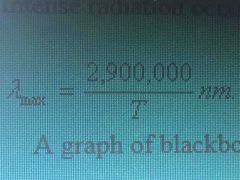![]()
![]()
![]()
Use LEFT and RIGHT arrow keys to navigate between flashcards;
Use UP and DOWN arrow keys to flip the card;
H to show hint;
A reads text to speech;
12 Cards in this Set
- Front
- Back
|
Wien's Law |

The wavelength at which the most intense radiation occurs |
|
|
The Hipparcos Mission |
Mission which operated from 1989 to 1993; launched a telescope into space for the purpose of measuring parallax angles for more than 40,000 stars |
|
|
BV Filters |
Way to determine temperature; B filter lets through a narrow band of blue wavelengths where the V filter lets through a narrow band of green wavelengths |
|
|
Henry Draper Catalogue |
Developed the system of spectral classification at Harvard in the 1920's |
|
|
Age of a Star Cluster |
Approximately equals the hydrogen-burning lifetime of the most massive main-sequence Stars remaining within it |
|
|
Apparent Magnitude |
A measure of the apparent brightness of an object in the sky |
|
|
Apparent Magnitude |
A measure of the apparent brightness of an object in the sky |
|
|
Absolute Magnitude |
A measure of an object's luminosity: defined to be the apparent magnitude the object would have if it were located exactly 10 parsecs away |
|
|
Spectral Type |
Designated by one of the letters OBAFGKM; tells us a star's surface temperature and color |
|
|
Spectral Type |
Designated by one of the letters OBAFGKM; tells us a star's surface temperature and color |
|
|
Luminosity class |
Designated by a Roman Numeral, is based in luminosity but tells us a star's radius |
|
|
Why are star clusters helpful to astronomers? |
-All star clusters lie in about the same distance from Earth -All star clusters formed at about the same time |

